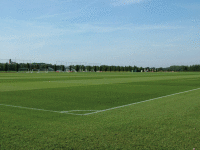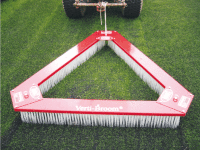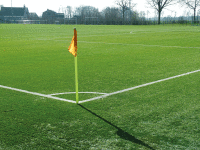Synthetic Turf - consider the x factor

Curtis Allen, Synthetic Specialist at Charterhouse Turf Machinery, explores the topic
We all know the list of advantages of a synthetic pitch - a one off investment; playable in all weathers, usable all year round; no maintenance requirements; larger revenue streams, to mention just a few reasons. But, what if these statements were not entirely true? If one has a realistic budget, and manages the perceptions and maintenance of the facility, then this will help expectations to go some way to being met.
Many of the facilities I see are installed to the highest standards, good design, specification and build - but then what? The gates are opened; the facility is used extensively with no more consideration being given to the high standards originally demanded when it was planned, designed and installed. This often is where the problem starts. Of course, a good thing will not always last forever but, if facilities want to provide a surface that is accessible to all, for many years, then they must consider the limitations of the facility. Simple planning at an early stage goes a long way to ensuring that the facility is not only safe and ready for continuous use, but also that the current carpet can be replaced when it reaches the end of its expected life.
Depending on the facility type, the initial funding of the pitch may need to be recouped and this should not be a problem if run as commercial entity - within 5-7 years of opening. With an expected lifespan of circa fifteen years, it should be able to offer a day to day return to the facility as well as creating a sinking fund to ensure money can be set aside for the eventual replacement of the surface. There are, of course, some caveats to this, namely maintenance and the strategy of the maintenance. Maintenance has a direct bearing on your liability, investment and budget, and is the single most important factor.
The maintenance does not need to be complex or costly, but it does need to be consistent and effective. When a synthetic turf surface is used, the footfall will naturally compact the infill and flatten the fibres; the infill is imperative in supporting

This is when we see surfaces which may look aesthetically good, but truly are not. The 'tell-tale' green haze of a 3G pitch tells the trained eye that the surface may not be receiving the maintenance it requires. It should have a slightly black 'tinge' to indicate the rubber infill is near the top of the fibres and is in situ to do its job. Should the fibres be left in the horizontal position, and play continues, then the most vulnerable part of the fibre is exposed to loading and UV. This will undoubtedly cause premature wear and breakage of the fibre, dramatically reducing the expected life of the carpet.
This is where the simplest and most effective tool any groundsman will own should be utilised - the brush. Whilst not the most engaging of descriptions, this tool will do far more than any other when used correctly at the right intervals. The brush should move infill around the surface, help alleviate compaction and stand fibres up, which should take no more than forty-five minutes to cover a full size surface.
It is commonplace to see an operator taking some two hours doing maintenance on the surface, only to see very little reward for the effort. Whilst it is good to see some activity, if it's the wrong type of brush or method then the result can be a very frustrating situation for all involved.
As a rule of thumb, the surface should be brushed once for every ten hours of use. This doesn't mean it is possible to spend five times longer brushing it after fifty hours play - consistency is the key here.

It is not necessary to utilise tines in the maintenance of surfaces; they can prove beneficial in reinstating some neglected longer pile (3G) surfaces but, on a day to day basis, they will not tend to benefit and may damage the surface. It is not advisable to use any sort of tine on a sand dressed or sand filled surface; these tighter knit, denser pile types of surface will not accept this action and will be susceptible to damage.
When calculating a maintenance regime for your surface, it is important to be aware it needs tying to the usage - the idea of ten hours use before brushing refers to a pitch being used in the normal fashion of twenty-two players (approximately) over the entire area. This is not always the case. The dividing nets now allow up to three games of eighteen players each to be played across the surfaces, which increases the total pairs of feet on the surface to fifty four (plus staff, referees and parents).
Using the 10-hour use rule by 22 players on the entire pitch area (6000 m2) as the standard (as mentioned previously), therefore 1500 hours of use equates to 150 brush maintenance requirements. Using the figure 5.5 (x as this standard, we can now calculate the comparison maintenance requirements as follows:
Calculation
No of hours play (per annum)
x no of players per hour
____________________ = x
Playing area m2
Full size site
1500 hours of play per annum
x 22 players per hour
__________________ = 5.5
6000m2
Five-a-side site
1500 hours of play per annum
x 10 players per hour
__________________ = 18.75
800m2
The calculator shows that, although the five-a-side site is a smaller area and has less players for the same amount of hours per year, it requires drastically more maintenance than the full size area. This does not mean the full size site needs less though. If we do the same calculation on the full sized site, but with the 54 players on the site, we get a figure of 13.5, meaning there is a required increase in maintenance of 145% to allow for the additional footfall.
Something that needs to be considered when planning usage for the surface is that it may need to be booked out to maintenance at some point in the day. Of course, the more usage, the more maintenance. The resultant factor x figure that you arrive at can be used as a benchmark and compared to other local facilities to see what maintenance ratio they have.

Experience shows that budget constraints, and individual perceptions, make the purchase of additional machinery two or three years later a difficult task.
When it comes to cleaning a surface, again the little and often approach has proved to be most effective. This is the case for two main reasons; firstly, the statement of liability as any foreign bodies on the surface are the responsibility of the facility; and secondly, most material on the surface is natural debris and detritus which, if left, will invariably get trodden on and broken down into the surface. This material will then migrate downwards and cause drainage problems.
The only way this material reaches the bottom of the carpet is from the surface, therefore, if it can be removed, it is a far more efficient way of caring for the facility. Machines like the Verti-Clean™ have proved to be invaluable for this task; the machine is lightweight and fast to cover the surface. The process does not take long and should be done on a regular basis to protect the user and the surface.
Of course, brushing and cleaning is not the complete answer to maintaining a synthetic surface. These facilities will also require more intensive cleaning to remove finer materials and particles that will have built up.
It is also the nature of synthetic surfaces to unintentionally work as a cleaning system for the water which passes through it, with the infill trapping dirt, dust etc. Until one day, the surface will no longer allow the water to pass through and reaches saturation point and the cry goes out; "our surface has been fine for the last five years and all of a sudden it has flooded".
There is an array of machinery for decompaction and deeper infill cleaning. These machines - the Verti-Top™ is a good example - sweep into the surface and lift the top layers of sand or rubber out of the carpet before seiving the material to separate larger pieces of debris, whilst a vacuum system collects smaller particles such as the dirt, dust and fibres from the surface, preventing the build-up of potential problems.
There are many considerations that can go a long way in the protection of the surface. For example, if boot scrapers/cleaners were not always painted the same colour as the fence, or placed out of the way, then they might be used more. When painted a bright colour, and relocated to a more apparent position, they will get used to clean the mud off user's footwear before they walk on the carpet.
In addition, access and wear is another consideration to educate all on. It is normal to have a 'lazy-end', invariably the half of the pitch nearest the gate. The team only need to train for twenty minutes, so they enter the facility and do what needs to be done - on the same

The maintenance of different types of synthetic surfaces, whether it be sand dressed, sand filled or 3G, is fairly similar. It will always be necessary to ensure the infill and fibre is working in harmony together. There are training courses available to educate and empower those charged with caring for such surfaces, and give them the skill set required to move forwards with the facility. Charterhouse are always happy to offer free advice and make site visits to assist.
A final tip, take a picture of the surface on day one and use that as a benchmark to monitor the surface over its lifespan.
